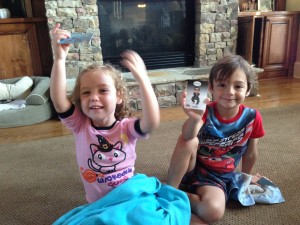 We all want our children to be model citizens. At the same time, we don’t want to be the parent who is constantly scolding, cajoling, or begging our child to behave. Indeed, one of the trickiest and hardest tasks as a parent is guiding a child’s behavioral development. It can be a real challenge, even when tackling the mildest behaviors. However, it’s not so frustrating when you can find and target the right motivation.
We all want our children to be model citizens. At the same time, we don’t want to be the parent who is constantly scolding, cajoling, or begging our child to behave. Indeed, one of the trickiest and hardest tasks as a parent is guiding a child’s behavioral development. It can be a real challenge, even when tackling the mildest behaviors. However, it’s not so frustrating when you can find and target the right motivation.
Children are best motivated by doing what their brains are wired to do… play!
Making a game out of behavior modification, or ‘gamifying’ it (to borrow a popular word these days), allows children to comfortably address issues in a positive way, and produces a willingness to comply which isn’t easy to match through other teaching methods.
A gamified program of behavior change engages the child through play. This puts the focus squarely on fun, pro-activity, and positive rewards -the desire to earn points or ‘win’ the game through good behavior. A token economy, for instance, is an excellent way to gamify behavior modification. In a token economy, goals and objectives are defined and a child earns tokens (in the form of marbles, stickers, “behavior-bucks”, or cards) for behaving in the desired way. Earn enough tokens and the child can ‘buy’ rewards or privileges. The token economy is great because it also teaches kids about the value of things.
There is no right or wrong way to create a gamified behavior modification program in your household. Every home is different, as is every family dynamic. However, below are a few tips and suggestions…
Keep Competition to a Minimum
First, remember that it is important to avoid competition among siblings; keep competition focused on the child with himself. Each child is an individual who deserves to be held to his or her own standard, and not that of their siblings. That said, the program can be implemented for each child in the family by creating individual goals for everyone. One of my favorite ways to do this is to create “bad behavior monsters”, which the child gets to defeat each day by earning positive behavior tokens for their own positive behavior efforts. One very fun way to implement this for boys is to load a Nerf gun with earned Nerf bullets and shoot down the bad behavior target. This reaches the child’s natural tendency toward play while reinforcing the idea of good versus evil, focusing on the behaviors and not the child himself.
Even rules can be fun
Create a fun atmosphere for following rules and creative means of reward. Structure does not have to mean strict adherence to punishment or rigidity. Structure is reinforced through game play, especially for children. If you think about most games that are played, rule following is one of the most important aspects of play. Children understand this dynamic more than any other. They are attracted to fun. Therefore, rule following and behavior modification that is fun, structured through games and appeals to the child’s sense of understanding are prone to be the most successful. If you’re using a marble jar, you can have a nightly ‘marble ritual’ where the days marbles are counted, the child recounts how they earned them, and they are ceremonially dropped into the jar.
Add Excitement
Finally, make goals exciting to be reached. Children thrive on excitement, especially when it is centered on their own efforts. This is the best way to implement a behavior modification plan that will successfully promote healthy, pro-social behaviors for your child. For instance, when using Awesome Deck of Awesome to encourage a child to get ready for school faster, multiple cards can be won for getting dressed quicker. Getting ready in 10 minutes nets the child 2 cards, while taking 20 minutes will only get them a single card. You can use a real timer to add to the excitement and fun.
Guiding a child’s behavior doesn’t need to mean endless begging, stern warnings, and strict punishments. By gamifying the behavior modification program you can motivate children to behave better on their own by tapping into their desire for play, fun, and excitement.
About the Author
 Douglas Kaufman is a devoted father and creator of Awesome Deck of Awesome, a positive reinforcement tool originally developed for his own son, but after repeated requests from friends and family, decided to make available to other parents with a similar belief in the power of positive reinforcement. When not being a dad, Douglas works as a brand consultant in Prague, Czech Republic.
Douglas Kaufman is a devoted father and creator of Awesome Deck of Awesome, a positive reinforcement tool originally developed for his own son, but after repeated requests from friends and family, decided to make available to other parents with a similar belief in the power of positive reinforcement. When not being a dad, Douglas works as a brand consultant in Prague, Czech Republic.
Awesome Deck of Awesome can be found on Amazon or by going to their website at http://deckofawesome.com. Also, be sure to visit their Facebook page at http://facebook.com/AwesomeDeckOfAwesome


 Some of the links on this site are affiliate links. If you click on those links and make a purchase, Kelli Claypool will receive a small commission. This is greatly appreciated as all affiliate income is donated back into our community as part of our Mission 500 Project. Affiliate links contained within a post are noted accordingly.
Some of the links on this site are affiliate links. If you click on those links and make a purchase, Kelli Claypool will receive a small commission. This is greatly appreciated as all affiliate income is donated back into our community as part of our Mission 500 Project. Affiliate links contained within a post are noted accordingly. Please note that Kelli Claypool is not, nor are any of our guest bloggers, Interns, or contributing writers (unless otherwise noted within their bio) certified nutritionists, herbalists, counselors or doctors. Information shared on this website is from our own individual research and/or opinion and is for informational and entertainment purposes only. Please conduct your own diligent research as we cannot be held accountable for any undesirable outcome.
Please note that Kelli Claypool is not, nor are any of our guest bloggers, Interns, or contributing writers (unless otherwise noted within their bio) certified nutritionists, herbalists, counselors or doctors. Information shared on this website is from our own individual research and/or opinion and is for informational and entertainment purposes only. Please conduct your own diligent research as we cannot be held accountable for any undesirable outcome. Thank YOU for being here! Without our readers and loyal listeners, this website would be a very quiet place. Thank YOU for taking the time to read our posts, listen to our shows, and give us your encouraging feedback. Our goal is to support you, to love you, and to inspire you to live victoriously in all areas of your life.
Thank YOU for being here! Without our readers and loyal listeners, this website would be a very quiet place. Thank YOU for taking the time to read our posts, listen to our shows, and give us your encouraging feedback. Our goal is to support you, to love you, and to inspire you to live victoriously in all areas of your life.
I have actually worked with Douglas. He does have very ‘awesome’ ideas. These tips are terrific. Thanks for the info!
Mistee, how cool! I’m sure you have an idea or two of your own then! I’m glad you enjoyed the article. Thanks for posting!
My mom made a game out of teaching me to read. Whenever I learned a new word, and could find it in whatever book she was reading I would get a sticker. Once I had enough stickers, I could trade them in for a small toy or a new book.the next time we were at the store. I also got stickers for helping set / clear the table at meals, and helping with laundry
Diane, wow! What great thinking on your mom’s part! I’m sure that helped quite a bit in an otherwise frustrating process. Thanks so much for sharing!